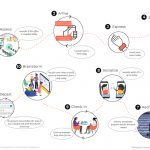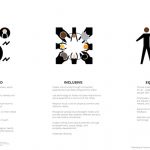Meet Team HOK San Francisco: The winners of the New Change Management Process category of the Next Work Environment Competition!

Palak Gadodia – Workplace Strategist + Change Manager, HOK
Kerri McShea – Senior Workplace Strategist + Change Manager, HOK
Lindsay Radford – Regional Leader of Healthcare Consulting, HOK
Kathleen Schwarz – Senior Healthcare Consultant, HOK
WDM: Since the pandemic what have you been up to / what are you working on?
Team HOK: Since the pandemic, we have been deepening our awareness of our own people’s needs and honing the advice and recommendations we can offer our clients. This is particularly relevant now, in the context of the challenges presented by the pandemic, racial inequality, and the multitude of environmental issues affecting the country.
Change Management is one of the most effective methods to foster employee engagement, empathy, and compassion. The personal and emotional side of change is at the forefront of this new process. By setting change in the context of an individual’s unique experience, we are focused on the human. We increasingly see the value change management provides.
WDM: What did you enjoy most about the competition process?
Team HOK: At HOK, serving humanity is at the core of what we believe. We embrace this responsibility through a positive culture based on the power of optimism, imagination and knowledge to innovate and merge artistic beauty with technical excellence in all we create.
As a multidisciplinary firm with experience and expertise in numerous markets, we always welcome the opportunity to collaborate will colleagues. In our case, we are spread across three time zones, and many of us had not previously worked together. We approached the project with open minds and a willingness to challenge preconceived notions – and had some fun along the way!
Working virtually meant that we experienced project related issues of “change” in real time. Acknowledging this motivated us to become active agents, not only in defining how the workplace must fundamentally alter in response to recent events, but also in finding a path for the individual through that transformation.
WDM: It’s been a little while since you submitted, how have your ideas evolved since you submitted them?
Team HOK: Our ideas have evolved by considering how the new change management process can be applied across a range of industries.
As HOK explores the future of the workplace through discussions with colleagues, trade partners, and clients, we develop a clearer vision for the future. We are expanding our team to include a wider range of subject matter experts to align the concepts with the future workplace, continue our research, and further develop the individual personas.
We are also piloting the process at our office in San Francisco to test and iterate the methodology. Our focus is on implementation by prioritizing actions based on leadership’s vision, maintaining cultural connections, and fine-tuning as we engage with employees and incorporate their feedback.
Check our their full submission:
With this liberation from the office, it is time to reimagine the workplace. With the majority of survey respondents expressing that they prefer to work in the office 2 to 3 days per week, and the minority reporting they would like to work in the office full-time (or not at all), the new work environment will be different from the one we left four months ago. Hybrid teams will work across geographies and time zones, synchronously and asynchronously, connected through a variety of technology tools that will enable virtual interactions, support simultaneous virtual and in-person engagement, and foster interpersonal relationships beyond the office.
One year or more from now, once we are able to return to the office with some level of normalcy, the workplace will become more tailored to support individual employee needs. This will be manifested in varying ways: for some it will be a place for socialization, for others a place for focus, while still others connect. The physical office may take many forms, such as a hub and spoke model, or a blend of co- working spaces and home offices. Regardless of the form, central to this new work environment will be its focus on the individual, designed through a truly human-centric approach. Outcomes will include a culture of equity, inclusion, and empowerment that honors the individual spirit in order to realize a collective mission and common goals.
There will be challenges to a hybrid work environment. The office has historically been seen as the nexus of an organization’s culture, and an expression of the company’s personality. If we aren’t always in the office, how can we stay connected to the culture, the work, our peers and leadership, our professional development and evolution within the organization at the same pace as our more office- bound peers? Must we depend on those that are physically present to remember those that are remote? If enough people make change happen, and the rules of engagement change, then change happens – but only if it is supported by a process that recognizes transformation is in the works and that everyone, at every level, must be involved.
View the submission below. Click on an image to see it full-size.
Comments from the judges:
This is a very thoughtful, thorough and inspiring submission. It combines attention to the individuals and teams’ workplace process plus changing styles and flexible needs over time. It creates a blueprint not just as a solution but as an algorithm to develop future solutions. Well done!
Realizing a human centric workplace was the strongest submission from the ones that I read because it provided a clear process map. It provided an emotional process map going through the five stages of grief and in a normal process and then through intervention, how you could minimize those stages of grief. It also provided “A Day in the Life” map with for personas. I found that extremely insightful and helpful in terms of getting my mind around what was going on and putting myself in the shoes of people that we’re going through this, not only the change management people or the employees, but the managers. I really liked the persona assessment.
A special thank you to our sponsors:













